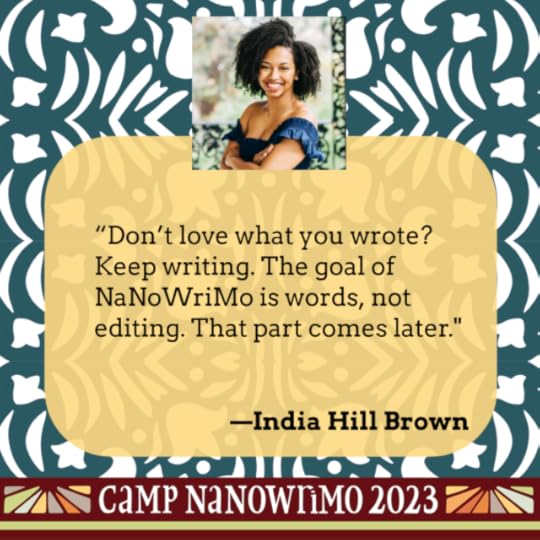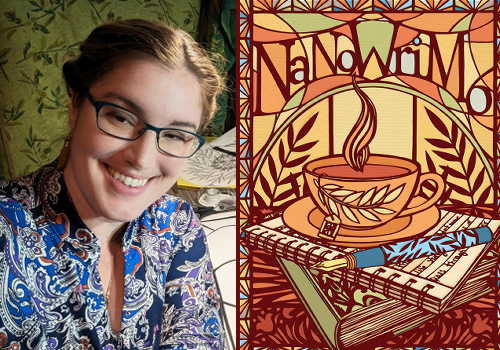Chris Baty's Blog, page 9
July 20, 2023
“Don’t love what you wrote? Keep writing. The goal of NaN...

“Don’t love what you wrote? Keep writing. The goal of NaNoWriMo is words, not editing. That part comes later.”
— India Hill Brown is an author with a passion for writing, reading, and all things literary. Her debut novel, The Forgotten Girl, has been nominated for an NAACP Image Award for Outstanding Literary Work in Youth/Teens and a 2020 ALSC Notable Children’s Book. She graduated from Claflin University with a Bachelor’s Degree in Mass Communications and with a Concentration in Print Journalism. In her spare time, she can be found curling up with a good book, a hot drink, and a snack. A self-proclaimed southern belle, she lives in the Carolinas with her husband and two sons.
July 13, 2023
Writing Tips for Every Age and Mental State

Not every piece of writing advice will apply to you — and that’s okay! Sometimes, your writing strategies will change as you go through life or learn more about yourself. NaNo Participant Clara Ward shares writing advice that they’ve learned over time.
There’s no right way to write. Writing—like life—is about finding your best fit. What follows are tricks that worked for me. Please borrow what works best for you right now. (Then save a few ideas for future you!)
I wrote my first novel four decades ago, when I was thirteen. I’ve written while juggling three jobs or zero. I’ve written as a kid, a parent, and an empty-nester. I’ve learned from my own neurodiversity and mental health challenges along the way.
Each struggle taught me how to customize my writing practice. Here’s a list of what worked for me at different stages. Adapt as you see fit.
Stage 1: Meet Yourself Where You’re AtOutline - For my first novel, I sketched furtive notes on the back pages of a school notebook. I created headings for each page that became section or chapter titles later. Numbers helped me order the scenes and letters delineated details.
Note: Leave extra space for fun facts or snippets of overheard dialog. Years later, I heard a NaNoWriMo buddy joke, “Careful, or you’ll end up in my novel.” My apologies to my high school geometry teacher, who received no such warning.
Avoid Distractions - I needed a closed door to write at first. I couldn’t read other fiction during the week or two when I frantically converted my outline into a rough draft. Luckily, I wasn’t in charge of meals back then!
Stage 2: Find Your PeopleGive Yourself Permission - I first heard about NaNoWriMo in 2004, when I was parenting, working, and volunteering as if there were two extra days in each week. I hadn’t written a story, an outline, or notes in over a year, but I knew exactly what I wanted to write. I signed up for NaNoWriMo and opened a family meeting by showing the webpage to my spouse and kids. I explained how I’d budget four hours a week for writing in November.
Note: I didn’t complete 50,000 words that first November. But the next year, my kids enthusiastically joined the Young Writers Program!
Enlist Support - Eventually, my kids and I designated one hour each day for writing. There were many distractions, but it felt great! We attended NaNoWriMo write-ins at a donut shop to build community, and my kids each persuaded a friend to join. (Yes, donuts are a sometimes food, but at least they weren’t asking for coffee!). With support and determination—and for me, a bit of sleep debt—we all met our writing goals most years!
Stage 3: Embrace Your True StrengthsEmotion Mapping - In the last couple decades, as attitudes and terminology evolved, I’ve learned a lot about my own neurodivergence and mental health. Oddly enough, the self-knowledge I gained by masking and compensating before I knew those words, informed both my writing and the tips given above. As I became more honest with myself, I brought more emotion to my writing.
Note: Sometimes it helps to skip scenes I’m not in a good headspace to write. I jot down key plot and character points inside curly brackets and skip to a scene that suits my current feelings. Since I don’t used curly brackets anywhere else in my writing, they’re easy to search for when I’m ready to go back.
Fascinations - After years of being warned about “info dumps,” I realized that my own fascinations (neurodivergent or otherwise) were assets that could serve my writing. At the beginning of 2020 I did a deep dive into researching sea creatures and ways to protect our oceans. At the back of my research notebook, I gradually outlined my 2020 NaNoWriMo Novel, Be the Sea. Parts of that outline cross-referenced pages of ocean research or articles I’d saved online.
Note: The system above worked well enough for me that I now have a book deal for Be the Sea, which will be published by Atthis Arts in early 2024!
Seriously though, this isn’t a post about how to get published on a 40-year plan. By matching your writing practices to your ever-changing self, you give all your stories the chance to be told. I wish you and your stories that success!

Clara Ward lives in Silicon Valley on the border between reality and speculative fiction. When not using words to teach or tell stories, Clara uses wood, fiber, and glass to make practical or completely impractical objects. Their short fiction has appeared in Strange Horizons, Decoded Pride, The Arcanist, and as a postcard from Thinking Ink Press. Clara’s 2020 NaNoWriMo novel, Be the Sea, will be available from Atthis Arts in early 2024. For updates on this and other projects, follow Clara on their website.
Photo by Anastasia Shuraeva from Pexels
July 10, 2023
A Letter to Writers who are Parents

Can you successfully write while also being a parent? NaNo Participant Desiree S. Brown confidentially says yes, you can do both. Desiree offers heartfelt words of inspiration to other author-parents out there.
My eyes were heavy with sleep as I plodded over to my son’s crib. I remember holding him in a state of awe, but I was also terrified. I hadn’t written in months—not from lack of trying—and had just emerged from a digital rabbit hole.
Desperate for pointers from seasoned author-parents, I asked Google, “How do authors write while raising kids?”
I expected encouragement, but found Lauren Sandler’s essay The Secret to Being Both a Successful Writer and Mother: Have Just One Kid and Cyril Connolly’s famous quote: “There’s no more somber enemy of good art than the pram in the hall.”
You can write and be a parent.
Many authors opted out of parenthood, believing each birth cost them a book. Doris Lessing, for example, had abandoned her children with their father in favor of her writing career.
It’s heartbreaking, but untrue. Zadie Smith, Toni Morrison, Jodi Picoult, Ursula K. Le Guin, Sarah Manguso and other authors managed to have successful careers while raising children. Manguso wrote in The Grand Shattering:
I used to believe that maximizing the number of hours reading, writing, and thinking about writing would make me the best writer I could be, and that my friend who had chosen to have three children just didn’t value being a writer as much as I did. Then I had a child and found that the amount of time I spend writing isn’t the only thing that makes me a better writer. I also grow by weathering trauma, practicing patience, being seasoned by love.
Parenting will help you grow as a writer.
Many author-parents noted an enrichment in their writing. In his essay, The Pram in the Hall, Shane Jones wrote, “I’ve discovered many writer-fathers who not only continued to produce work, but produced work that is richer and more interesting because of their fatherhood.”
New life moments create powerful experiences and what is storytelling, poetry, or essays but the exploration of those experiences? Parenting shaped me and my writing in a way that childlessness couldn’t. I’ve learned to be more empathetic and honest with my time management (why didn’t I write during my son’s two hour nap?).
Jodi Picoult learned to be “hyper-aware of relationships between people,” Jane Smiley’s kids exposed her to new ideas by forcing her into the world, and Maggie O’Farrel learned “to concentrate with the intensity of a telekinetic.”
You’re not neglectful for prioritizing writing or parenting.
There’s a constant tug of war within writer-parents, not to mention the crushing weight of social expectations: writers need silence at all times and parents prioritize their kids.
But that’s an unrealistic standard that will ruin any parent’s mental health, resulting in a loss of self, depression, and frustration. O’Farrel writes:
Don’t feel guilty about taking time to write. Guilt is no use to you here. Throw yourself headlong into whatever is in front of you, whether it’s writing or doling out small bowls of pasta or making potato prints. It’s good for your children to have a fulfilled parent, not a frustrated one. A child witnessing their parent working and being gratified by that work is an excellent lesson for them.
So, what’s the answer to the big question? How do authors write while raising kids?
They do it like anyone else: stealing time between diaper changes and naps; juggling housework, parent-work, and writer-work as best as they can; and realizing that they have the potential to create a fulfilling writing career like anyone else.
That’s the answer I will carry with me into Camp NaNo, the next project, and beyond.

Desiree S. Brown is an author that lives in the sunny state of California with her husband and son. She publishes her work on her website, desireesbrown.com, while also sharing her passion for reading and writing.
Photo by SHVETS production from Pexels
July 6, 2023
NaNoWriMo and the Meaning of Sunshine

Did you know that National Novel Writing Month is a 501©3 nonprofit? Today, NaNoWriMo Executive Director Grant Faulkner explores the guiding metaphor for how he thinks of NaNoWriMo—and how we’ve been approaching fundraising. ( For more, see Community Fundraising Means Showing Up for Each Other.)
NaNoWriMo is an ecosystem.
No, NaNoWriMo is part of an ecosystem—it’s a community within an ecosystem, like a grove of apple trees in a wider ecosystem that also includes butterflies and bees (let’s say they are the writers, pollinating the world with stories), forest sprites (because ecosystems hold magical possibilities), flora and fauna, and a running brook.
The organisms that live in our ecosystem go beyond writers and forest sprites, though, and include schools, readers, teachers, libraries, book stores, and other writing organizations—all interconnected because we develop our stories, our voices, our discipline, our joy, our purpose, and our imagination with others, not just alone.
A single tree, no matter how large and mighty, can not sustain itself without the tiniest microbes of life teeming in the soil around its roots.
The ecosystem flourishes when all of its elements are working together—when organizations like NaNoWriMo can nourish writers and teachers and schools, and everyone grows creatively, lifting each other up, cheering each other on.
But to flourish, the ecosystem needs something else: it needs sun and water, and the sun and the water take the form of donations. This is why we ask for donations. Without the sun and water of others’ support, the ecosystem becomes stressed—as if there has been a drought or deforestation (or a “destorystation,” God forbid).
The Symbiosis of StoriesSome people view ecosystems and the species within them through the lens of competition—i.e., only the strongest survive. But the definition of a healthy ecosystem is one that’s symbiotic—where relationships are formed and resources are exchanged and growth happens in harmony.
We are all called upon to contribute to this ecosystem, whether it’s by donating or volunteering or simply spreading the word. A healthy and diverse ecosystem is one that provides abundance to those who live in it—food, shelter, recreation, and natural beauty.
“Nature is not a place to visit, it is home,” said the poet Gary Snyder.
Just like our stories are our home. Our stories provide shelter. Our stories give sustenance. Our stories help us breathe. Our stories connect us to others. And our stories help us see the forest sprites that would otherwise be invisible.
Our contributions to this story-powered ecosystem are meaningfully rooted in the support of our donor community. Year to year, we’ve had anywhere from 6,000 to 8,000 of our writers join us with a small dollar donation. Thanks to this support, we’re proud to be a largely community-funded organization with more than 35% annual revenue coming from individual donors.
We’re deeply grateful that so many shine your light on NaNoWriMo each year. As we head into our busiest season, we hope you think of how you can contribute to the NaNoWriMo community and the ecosystem it’s part of. We want to provide the apples on our trees to everyone so they can taste the sweetness of their creativity.

Grant Faulkner believes in NaNoWriMo because stories tell us who we are and shape the world we live in. He has been a writer since his earliest memory, and he’s proud to be the author of Pep Talks for Writers and Brave the Page. He struggles with rough drafts (hence his love—no, his need—for NaNoWriMo), but luxuriates in revision. His dog Buster serves as his lap dog/lap desk and has traveled with him for thousands and thousands of words.
Top photo by Dan Freeman on Unsplash
June 29, 2023
5 Techniques to Help You Write Your Novel

Every writing project is unique, and the methods that help you draft one novel may not work for another. If you’re getting started on a brand new project this Camp, NaNo Guest Vee James has some suggestions for different techniques to help you explore your story.
It took a few NaNos before I realized I was developing different techniques each time I sat down to the challenge. I think we all do this naturally, but it helps to step back and observe the process. If you’re strictly a pantster, you’ve been working on the story ideas in your head. If you’re a planner, you’ve set to put the story concepts, characters, and an outline of what you are about to produce on paper. Some people take a hybrid approach to NaNo. Granted, the basics remain the same: butt in chair, accomplish the hourly/daily goal, and allow yourself to tell your story.
I discovered that each unique novel presented particular challenges, and I had to adapt my style and writing techniques in order to explore the story and keep the production happening. Some of these came from writing instructors and wonderful podcasters. Some came from “how to write” seminars and workshops. Others grew out of a feverish search for “more words.”
Here are five techniques I’ve found that helped me advance writing projects:
1. ResearchIt was a surprise to me to discover the concept of researching for fiction. I initially thought, “Just make something up.” But there are so many ways to broaden your approach. Plumb your memory, take a course in something related to the story, talk to an expert, and ask lots of questions. You could even become like the character in order to feel what they feel. If you’re writing a western, go ride a horse.
2. Write Scenes Out of OrderIf you have a premise, you’ve already got scenes in your mind. Don’t wait until you get to chapter 18. Write that scene now. You can always revise it when you catch up to that point and it gives you something to develop toward. To expand on this technique, when you’ve written the scene, ask yourself, “What happened just before this?” or “What does this scene lead to?”
3. Put disparate characters together and have them have a conversationOften, we write secondary characters who take a more subdued role in the plot. But what would happen if your protagonist’s best friend had a conversation with the main antagonist? Or if the antagonist’s agent of destruction came upon the protagonist’s love interest? In my experience, these conversations frequently produce more depth in your secondary characters and almost always it’s something you weren’t expecting.
4. Play with Genre TropesWhat have you chosen to write? Urban fiction? SciFi? Fantasy? You already know what your reader expects you to write, and what the plot ahead holds for them. How can you twist it? Sometimes the simplest thing you mentioned in chapter one can be the linchpin of a great plot twist.
5. Study FilmIt’s no accident that some of the most astounding stories have been told through film. Quite simply, movie companies invest heavily in every aspect of their production and hire some of the best writers around. Yes, it’s a visual medium and has some advantages over prose. But the main lesson with movies is in the structure of the stories they tell. Here’s a good example: when I was writing a fairytale novel, I wanted to stay true to the classic story structure. One afternoon I was watching the comedy, Galaxy Quest, taking careful notes on the structure. I realized the story structure mapped very closely to what I was doing in the fairytale. It was comforting to see this, and it also gave me some ideas on how to approach the ending.
Most importantly: NaNoWriMo is a thrilling if exhaustive experience, and I urge you to immerse yourself in it completely. Write with utter abandon, delve deep for concepts that will give you the next 2000 words, and try new things like you’re a Mad Scientist in a hurry. We all know that what you end up with is a messy creation. But you will find you have given yourself a great gift.

Vee James is a cross-genre author who loves to write comedies, fairytales, and YA supernatural. He participated in NaNoWriMo for ten years in a row, writing over a half-million words, and it led to nine NaNo novels plus two more non-NaNos. Out of this work, he’s published four novels, with a fifth nearing completion. If interested, visit his site at www.veejames.com and leave a message. He loves to talk to writers of all kinds.
Photo by Daniel Álvasd on Unsplash
June 28, 2023
5 Tips for NaNoWriMo First-Timers

Feeling nervous as a new Wrimo? NaNo Guest Demi Michelle Schwartzhas advice for you! Read on for tips on how to make sure your first attempt at Camp NaNoWriMo is a great one.
Have you heard about the NaNoWriMo or Camp NaNoWriMo buzz? Are you on the fence about taking the challenge for the first time? If yes, I’ve been in your shoes.
Last year, I got a new novel idea I was eager to write. I love challenges, and NaNoWriMo looked like the perfect time to draft my story. Still, being a first-timer gave me nervous butterflies. Little did I know I’d win my first NaNoWriMo with a finished draft at 73,000 words.
Whether you’re planning on participating in Camp or thinking ahead to November, I have five tips for you.
1. Plot and Research in AdvanceFirst, I can confidently say I wouldn’t have been successful if I didn’t plot and research. Having a solid story idea from the start gave my writing direction each day.
If you’re a pantser, this may contrast with your process. Rather than completely plotting the novel, see if you can at least plan major beats or turning point scenes. That way, you’ll have plot points to write towards.
Also, doing research in advance reduces the amount of times you’ll have to pause to look something up. You may have to google information here and there, but a head start will make these internet-surfing adventures minimal.
2. Plan a Writing SchedulePlanning a writing schedule is key. For me, I’m most productive when I first wake up before I’m swamped by the day’s tasks. Also, I write well before bed, as long as I’m not too tired. Knowing when you write best will allow you to plug in time to work on your story.
Also, look at your calendar and plan accordingly. Part of my NaNoWriMo goal was writing every day, but I had to work around other commitments. Last November was a busy month for me in my songwriting career. So, I had to adjust my writing schedule during busy release and press days.
Having a plan for when you’d like to write and being aware of days you can fit in more time with your story will give your journey structure.
3. Remain FlexibleI can’t stress enough how important it is to remain flexible. No amount of planning can prepare you for curve balls or days you’re not in a creative mood.
If you go into NaNoWriMo thinking all your plans are set in stone, you may find yourself feeling anxious when something veers off course. Remaining flexible gives you room to adapt while staying on track.
4. Interact with the CommunityNaNoWriMo has a special community. Whether you’re connecting with other writers on the website or on social media, everyone is so supportive.
There’s nothing better than participating in an event where writers are cheering each other on and sharing experiences. You may make friends and connect with critique partners and beta readers. Most of all, you’ll realize you’re not alone as you take the NaNoWriMo challenge.
5. Celebrate All Your WinsFinally, celebrate all your wins. Recognize when you draft your first chapter. Give yourself a pat on the back when you hit a certain word count. If you’re doing a streak, feel proud for writing several days in a row.
Sometimes, as writers, we only focus on our end goal. It’s important to remember the small wins along the way play a role in reaching the desired result.
There you have it. Those tips allowed me to succeed during my first NaNoWriMo. There’s an international community of writers ready to welcome you, so get out there and become a Wrimo!

Demi Michelle Schwartz is an author from Pittsburgh, PA. She writes young adult fiction and enjoys the mystery, thriller, and fantasy genres. After earning BAs in Creative Writing and Music from Seton Hill University, she went on to pursue her MFA in Writing Popular Fiction at Seton Hill and graduated with her degree in June of 2022. When Demi isn’t working on her manuscripts, she’s busy chasing her other dream as an award-nominated songwriter and recording artist. Check out her website, Twitter, and Instagram!
Photo by cottonbro studio from Pexels
June 21, 2023
Five Scenes That Make or Break Your Novel

Every year, we’re lucky to have great sponsors for our nonprofit events. Bookflow, a 2023 NaNo sponsor, is a cloud-based writing tool that helps writers stay motivated and organized. Today, Bookflow shares five important scenes to consider when writing or editing your novel:
At Bookflow, we’re all about helping writers start writing and keep writing. What stops writers from writing? Overwhelm, fatigue, perfectionism, fear, life events—there are an infinite number of reasons why we take a pause and then, sometimes, fail to get started again. At Bookflow, we’re all about focusing on how to make writing feel doable, so that you can get in the flow and stay there…all the way to “The End”.
Promoting the positive energy of experiences like Camp NaNoWriMo is what we’re all about. After all, writing isn’t just something we do when we’re putting words on the page: it’s a way of life, a way of seeing the world through a creative lens. Bookflow makes it easy to capture and organize the thoughts that make up a novel’s raw material, and then turn that material into a finished draft.
Writers often get stuck in their plots or struggle to see the big picture behind their manuscript’s events. But the basic structure that underlies most stories in the Western tradition is actually fairly simple. (Simple, of course, does not necessarily mean easy!)
According to playwright David Mamet, plots have five foundational moments. Here, we explain what each of these moments means.
1. Once Upon a TimeWe can’t understand why something changes if we never understand what things were like before that change. Consider what an ordinary day was like for your protagonist before their main conflict arrived. Were they happy? Dissatisfied? Frightened? Content?
2. And Then One DayThis is the moment that things change for your protagonist. And then one day…Gandalf handed me a magic ring. And then one day… I woke up and was a cockroach. And then one day… the prince invited everyone to a ball. Usually, this scene will appear at or near the start of your novel, and will set things in motion as your character makes a plan to get what they want.
3. And Just When Things Were Going So WellThis is a major reversal that happens approximately midway through your novel. After initial setbacks, your protagonist seems to be on the verge of success…only to fail in a way that seems catastrophic. This causes the character to contemplate giving up entirely. But after they deal with the emotional fallout of their failure, they reassess their actions and what they are willing to do to get what they want or need.
4. When All of A SuddenThe character’s new plan has worked, and they seem to be on the brink of success. But near the end, they face an enormous, final setback that looks as if it will end in disaster. However, the character’s earlier challenges have helped the character grow. They put everything on the line (emotionally or physically) in a final bid to achieve the outcome they want.
5. And They All Lived Happily Ever AfterSometimes they all live happily ever after (Cinderella). Sometimes they don’t (Macbeth). But there’s always a decisive moment in which the protagonist achieves their goal, fails in their goal, or a mixture of both. Either way, once the outcome is decided, your story is effectively over. Tie up any loose ends and write The End—you did it!
Bookflow is a comprehensive (but easy to use!) tool to help you build out characters and scenes that work and organize your writing into a successful novel. If you’d like a copy of our free outlining guide, click here!
Bookflow is the cloud-based writing tool that helps writers stay motivated and organized. Track streaks and goals, organize and re-order your manuscript, and find daily inspiration and writing prompts with the tool that gets you all the way to “The End”. Camp NaNoWriMo writers get 30% off an annual subscription when you sign up with code NANOWRITER. Offer expires August 1, 2023.
Top photo by 愚木混株 cdd20 on Unsplash.
June 14, 2023
Unlocking the 8 Secrets of Web Novels

If you’re looking to try something new this Camp NaNoWriMo, why not a web novel? Participant Eitan Estheimtalks about what a web novel is and how to get started on your episodic writing adventure!
The act of writing has been with us for a long time, but that doesn’t prevent us from learning different ways to approach it, especially when we take advantage of the new technologies that are emerging.
Web novels (and their variants) are original stories that are published on the internet in chapters, instead of offering the finished product from the beginning. They resemble self-publishing because the author takes care of the entire process (writing, editing, publishing, promotion), and fanfiction because they maintain close contact with the readers.
Generally, authors usually offer their content for free on the internet. However, some authors will publish in advance on Patreon to offer incentives and get monthly paid subscriptions as if it were the Netflix of books.
I’ve been doing this for a while now and, although I don’t have the impact of other writers, that hasn’t stopped me from learning a lot in the process. With this in mind, I’m going to tell you what I’ve learned, both on my own and thanks to others.
1. Choose where to publish your web novel. Nowadays, there are several platforms such as Wattpad, Royal Road, Tapas or Kindle Vella, among many others. Some are more suitable for romance and contemporary stories, while others highlight fantasy or litRPG. Keep this in mind before deciding where you want to start.
2. Be prepared. Unlike other ways of publishing a book, a web series requires regular updates. This means you need to create content frequently. As a result, many authors choose to have several weeks of chapters prepared. This ensures they can continue publishing while writing the next chapters, along with all the additional tasks that this entails.
3. Be realistic with your time. Referring to the previous point, we need to take a moment to consider everything we must do: write new content, make sure it’s in good condition for publication (editing), promote on social media, etc. Many of us have jobs and responsibilities, so we must be aware of how much we can accomplish each day.
4. Every story is unique. What works for one author may not work the same for another. Some decide to publish short chapters from Monday to Friday, while others prefer to do it once or twice a week. Consider your situation and learn as you go to figure out what works best for you.
5. Take care of yourself. If you push yourself too hard, both in external obligations and in your own projects, you will reach a point where you will exhaust yourself (and that’s if you’re lucky). Just like in life itself, prioritize your physical and mental health, fulfill your responsibilities, and give yourself the opportunity to write under the best possible conditions.
6. Share your story. Maybe you’re like me and prefer to dedicate your time to writing, planning, and editing because that’s what you enjoy the most. It’s understandable, but how will you get others to read your work? Get moving! Use social media, Facebook groups, and other methods because if you want others to value your work, you must make them aware of it.
7. Find your balance. Just like in any other writing project, there will be times when you write less and dedicate more time to editing or preparation. You may have periods where you write less, but that doesn’t mean your productivity is lower; it just means there are other equally important tasks you must perform. Finding the right balance will allow you to progress in your short, medium, and long-term projects.
8. Take care of your readers. Remember what I mentioned about Patreon? It’s not only a way for authors to receive some compensation for their work, but they also offer incentives to their followers. Most choose to offer chapters in advance, but they can also provide exclusive access to Discord/Guilded servers, EPUB/PDF files to continue reading on other devices, unlimited scenes, and a variety of other things. Just think about what you would like to have as a reader, and I’m sure you’ll come up with many ideas.
All of us here know how complex and exhausting writing can be, regardless of the project we’re working on. However, it’s equally rewarding to see our story taking shape and sharing it as if it were our own TV series. You just need to mold it in the way you desire and keep on writing!

Eitan Estheim, a passionate web serial writer hailing from Spain, is a humble virtuoso of storytelling. From an early age, armed with nothing more than a trusty notebook, Eitan embarked on a literary journey fueled by lots of chocolate. His insatiable thirst for knowledge knows no bounds, as he tirelessly hones his craft to captivate readers. Eitan’s web books, spanning fantastical realms and heartfelt LGBT dramas, written in Spanish and English, mark the beginning of his promising writing career. Follow his journey on Patreon!You can also visit his website, Tumblr, Instagram, or Pinterest.
Photo by MART PRODUCTION from Pexels
June 8, 2023
Five Ways NaNoWriMo Turned Me into a Writer at Fifty-One

No matter your age, NaNoWriMo has something to offer for you. For participant, Dorothy Wong, Camp NaNoWriMo gave her the chance to finish a novel! Read below to learn about her experience and what she gained during her writing journey.
The year I turned forty, I took a twelve month leave from my job. With no work commitments, I thought I would finally write my novel. While I ended up with a blog full of chatty travel posts and fantastic memories, I didn’t write my book, not even a rough outline. Anytime I tried, I found myself distracted and overwhelmed. If I couldn’t write during that sabbatical year, I told myself, I was never going to write anything. And for almost a decade, I didn’t.
Then a friend posted on Facebook that she was attempting a month-long writing challenge called NaNoWriMo. My first thought was, “Why would anyone voluntarily sign up for that?”. I couldn’t imagine putting myself under that time pressure to produce an actual novel.
Turns out, NaNoWriMo was exactly what I needed to break through my self-imposed barriers to writing. During Camp NaNoWriMo April 2021 I went from never writing at all to writing an average of 1500 words per day and creating a flawed, but completed, 50,000 word manuscript. I was ecstatic. Not only did I finish a novel, I thoroughly enjoyed the process.
Here are the top five ways NaNoWriMo turned me into an enthusiastic writer at fifty-one:
1. Community: There’s nothing quite like being part of a group effort, where everyone is cheering you on to complete your 50,000 words. NaNoWriMo is dedicated to creating safe and diverse spaces, including providing online and in-person opportunities to meet fellow writers. As an older writer, I worried about keeping up when the participant age range skewed much younger. To my relief I found a community through the BIPOC online meet-ups that connected me to others like me, many with established careers and extensive life experience, who wanted to write. Finding a community of writers will give you the support you didn’t know you needed.
2. Timed Sprints: During my first online writing sprint, to my absolute shock, I churned out 600 words in 15 minutes. Being in the company of others who are all doing the same thing (known as “body doubling”) really worked for my brain. Scientific studies show that doing a task in tandem with others increases productivity. If you’ve never tried timed writing sprints, they can be a game-changer.
3. Word Count Tracker: NaNoWriMo’s online word count tracker sent an instant dopamine hit to my brain every time I updated my progress.
4. Word Count Goal: While writing an entire novel can be daunting, reaching 50,000 words felt doable. Broken down to 1500 a day, I worked in short bursts throughout the day, finding time around my job and caring for my family, to get that word count in. When I reached my goal each day, I felt incredibly motivated to keep going. Even if I didn’t reach the goal, getting some words down every day kept my inspiration burning.
5. Limits are Freeing: NaNoWriMo’s time-bounded word count freed me from the “what if it’s not any good” voice in my head. If I wanted to write, I had to sit down and write, no excuses, and I had to keep moving the story forward, as there was no time to go back and edit. By accepting that I would be writing a crappy first draft, I gave up perfection and embraced the challenge.
NaNoWriMo made me finally believe that I could write a novel. If you’ve spent a lifetime trying to get started on your novel, I encourage you to give NaNoWriMo a try!

Dorothy Wong lives with her family on beautiful Vancouver Island, British Columbia, Canada where she works as a lawyer by day and writes mysteries by night. She joined NaNoWriMo in 2021 and has been happily writing ever since.
Photo by Toa Heftiba on Unsplash
Interested in the writing events Dorothy talked about? Feel free to check out our upcoming events for Writers of Color Virtual Meetups or Virtual Write-Ins! Writers of Color are also invited to check out the forum group.
June 6, 2023
NaNo Interview: 2023 Camp Designer Elizabeth Goss

Camp NaNoWriMo is almost here! You’ve probably already seen the beautiful papercut inspired designs in our shop. Today, we’ve interviewed our graphic design Elizabeth Goss about her project!
In college, I had to create a cut paper animation inspired by the work of Lotte Reiniger. I fell in love with the process of papercutting. I’ve gone through several style changes over the years, but I’ve been cutting paper since that project.
Q: What was the trickiest element of the process for you? What was the most fun?I really enjoyed this whole process. It was wonderful to have so much creative freedom. The trickiest part was wanting to turn all my sketches into final art! That’s pretty unusual. I may try to finish a few pieces over the summer, just for myself.
Q: NaNoWriMo is all about challenging ourselves to take on the sometimes painstaking work of writing and editing. What parallels do you see between noveling and papercutting?I think there are some powerful parallels between writing a novel and papercutting. Whether you’re working with words or paper, it takes tremendous patience and persistence to create a finished work that matches the vision in your head. I also think both processes require a little audacity. It takes courage to bring something into existence and even greater daring to share that precious creation with strangers.
Q: If your papercut practice was a sandwich, what kind of sandwich would it be?
Oh, what a fun question! If my papercutting were a sandwich, it would be a grilled cheese—simple ingredients, endless creative possibilities. Papercutting is a wonderfully accessible art form. It doesn’t require specialized or expensive tools, just paper and something to cut with, yet you can create an enormous variety of work. I love a classic grilled cheese sandwich, but I appreciate that, if the mood takes me, I can throw in some caramelized onions or pesto and enjoy something totally different and delicious. Papercutting is the same way. It offers endless variations and styles to explore.

Elizabeth Goss is an illustrator, author, and papercutter based in the Pacific Northwest. Her first picture book My Way West: Real Kids Traveling the Oregon and California Trails (West Margin Press, 2021) won the Paterson Prize for Books for Young People. Her new picture book, All About Nothing (Charlesbridge, 2023) is a collaboration with decorated children’s author Elizabeth Rusch and celebrates all the positives of negative space.
Chris Baty's Blog
- Chris Baty's profile
- 63 followers



